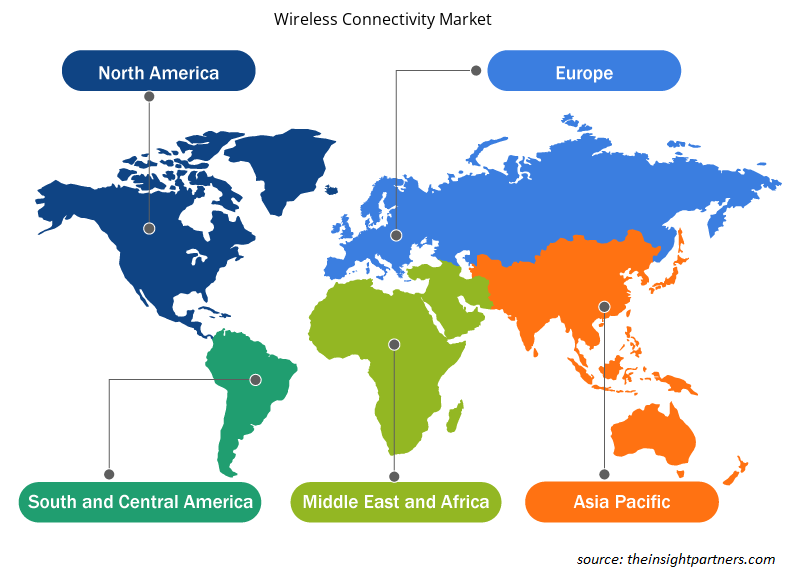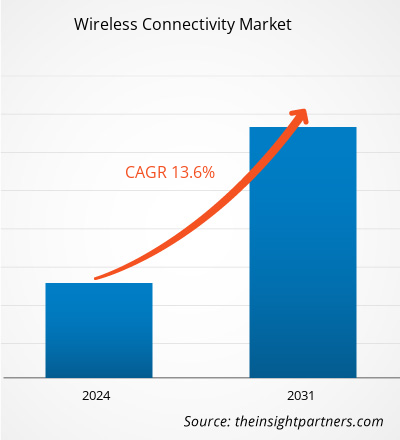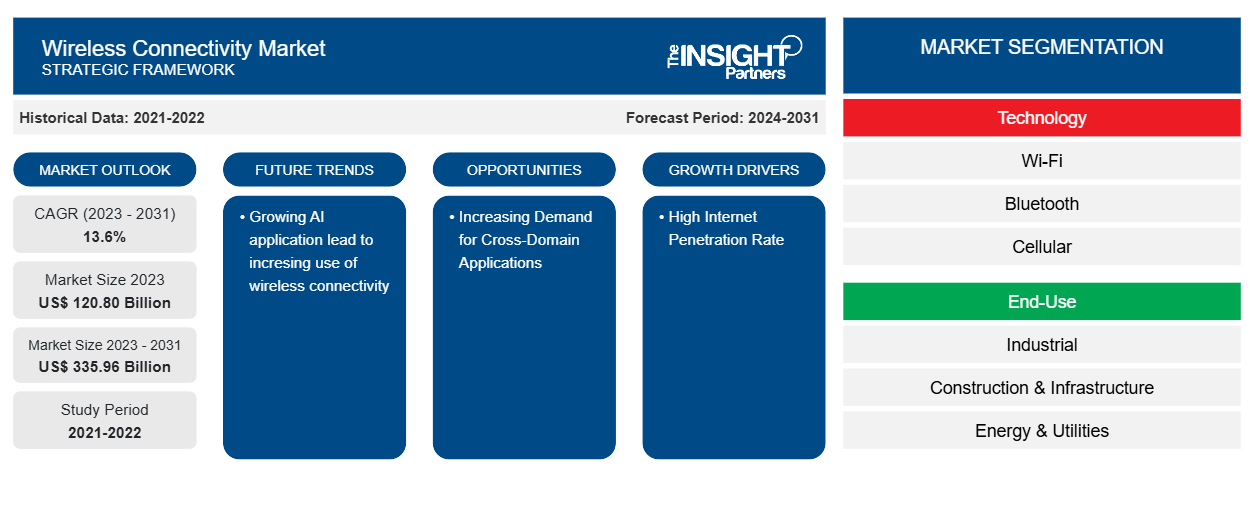무선 연결 시장 규모는 2023년 1,208억 달러에서 2031년까지 3,359억 6,000만 달러로 성장할 것으로 예상됩니다. 이 시장은 2023~2031년에 13.6%의 CAGR을 기록할 것으로 예상됩니다. 글로벌 무선 연결 시장은 클라우드 컴퓨팅 및 관련 기술에 대한 수요 증가로 인해 예측 기간 동안 상당히 증가할 것으로 예상됩니다.
무선 연결 시장 분석
또한 무선 연결을 통해 고객은 현저히 낮은 지연 시간으로 데이터를 전송하고 정확하게 차량을 찾을 수 있습니다. LTE 및 LTE Advanced와 같은 최신 통신 네트워크를 사용하여 스마트 자동차와 통신할 수 있습니다. 스마트 주행은 향상된 5G 네트워크와 사물 인터넷으로 효율적으로 관리됩니다. 임박한 장기 진화(LTE) 출시, 향상된 스마트 기기 사용, 이동성 증가, 모바일 데이터 트래픽의 빠른 증가를 포함한 무선 통신 분야의 수많은 발전이 무선 기술 에 대한 수요를 견인하고 있습니다 . 최신 무선 기술은 더 큰 에너지와 스펙트럼을 요구합니다. 가장 빠르게 확장되고 있는 두 가지 모바일 기술은 LTE와 5G이며 앞으로도 계속 개발될 것입니다.
무선 연결 시장 개요
소비자용 전자 기기에 대한 수요 증가는 시장 성장을 촉진할 것입니다. 더욱이 AI, IoT, AR, VR과 같은 정교한 기술은 다양한 최종 사용자 산업에서 인기를 유지할 것으로 예상됩니다. 스마트 인프라의 글로벌 개발도 무선 센서 네트워크 수요의 주요 원동력입니다.
인포테인먼트 시스템은 Wi-Fi 및 Bluetooth와 같은 무선 연결을 통해 스마트폰 및 기타 스마트 기기에 연결할 수 있습니다. 인포테인먼트 시스템은 사용자의 가젯과 페어링할 수 있습니다. 운전 중 전화를 받고, 음성 지시에 반응하고, 시스템을 쉽고 편리하게 작동하기 위해 핸즈프리 모드를 처리할 수 있습니다.
귀하의 요구 사항에 맞게 이 보고서를 사용자 정의하세요
이 보고서의 일부 또는 국가 수준 분석, Excel 데이터 팩을 포함하여 모든 보고서에 대한 사용자 정의를 무료로 받을 수 있으며 신생 기업 및 대학을 위한 훌륭한 혜택과 할인 혜택을 이용할 수 있습니다.
- 이 보고서의 주요 시장 동향을 알아보세요.이 무료 샘플에는 시장 동향부터 추정 및 예측까지 다양한 데이터 분석이 포함됩니다.
무선 연결 시장 동인 및 기회
높은 인터넷 침투율이 시장을 선호합니다
지난 10년 동안 선진 북미 및 유럽 국가의 인터넷 보급률이 극적으로 확대되었습니다. Internet World Usage Statistics에 따르면 2022년에 인터넷 사용자의 54.2%가 아시아, 유럽에 있었고 66%가 북미에 있었습니다. 중동과 아프리카는 인터넷 도입률이 가장 높습니다. 모바일 기기에서 인터넷 사용이 증가하고 있습니다. 인터넷 액세스가 더욱 중요해짐에 따라 무선 스마트 가젯에 대한 필요성이 커질 것입니다. 향후 5년 동안 전 세계 M2M(Machine-to-Machine) 연결 수가 두 배 이상 증가할 것으로 예상됩니다. M2M 연결은 제조 시설 배송 차량과 창고 자산 추적 시스템에서 발생합니다.
크로스 도메인 애플리케이션에 대한 수요 증가
무선 기술을 최대한 활용하려면 교차 도메인 기술과 협력이 필수적입니다. IoT 및 클라우드 컴퓨팅 생태계는 조직과 기업에 기하급수적인 개발 전망을 제공합니다. 조직은 새로운 클라우드 및 IoT 추세와 기술 혁신에 대응할 수 있습니다. 조직 성과는 부문 간 관계와 비즈니스 전략에 따라 달라집니다. Huawei Technologies(중국)는 웨어러블 기기, 스마트 홈, 차량 인터넷, 스마트 미터 , 산업용 인터넷과 같은 다양한 세그먼트를 겨냥한 새로운 운영 체제인 LiteOS7을 출시했습니다. Huawei Technologies(중국)는 IoT 생태계 내에서 여러 시장 범주로 확장했습니다. 이를 통해 조직은 IoT에서 다양한 애플리케이션을 타겟팅할 수 있습니다.
무선 연결 시장 보고서 세분화 분석
무선 연결 시장 분석에서 중요한 요소는 기술과 최종 사용입니다.
- 무선 연결 시장은 기술에 따라 Wi-Fi, 블루투스, 셀룰러, ZigBee, GNSS 및 기타로 구분됩니다.
- 무선 연결 시장은 최종 용도를 기준으로 산업, 건설 및 인프라, 에너지 및 유틸리티, 자동차 및 운송, 의료, 소비자 및 기타로 구분됩니다.
지역별 무선 연결 시장 점유율 분석
무선 연결 시장 보고서의 지리적 범위는 주로 북미, 아시아 태평양, 유럽, 중동 및 아프리카, 남미/남중미의 5개 지역으로 나뉩니다. 아시아 태평양 시장은 무선 연결 시스템의 가장 빠른 성장을 경험할 것으로 예상됩니다. 예를 들어, 미중 경제 및 안보 검토 위원회는 올해 중국의 스마트 시티 이니셔티브에 대한 정부 투자가 389억 2천만 달러에 이를 것으로 추정합니다. 스마트 인프라의 성장은 무선 통신 시스템에 새로운 기회를 창출할 가능성이 높습니다.
무선 연결 시장 지역 통찰력
Insight Partners의 분석가들은 예측 기간 동안 무선 연결 시장에 영향을 미치는 지역적 추세와 요인을 철저히 설명했습니다. 이 섹션에서는 북미, 유럽, 아시아 태평양, 중동 및 아프리카, 남미 및 중미의 무선 연결 시장 세그먼트와 지리에 대해서도 설명합니다.

- 무선 연결 시장에 대한 지역별 특정 데이터 얻기
무선 연결 시장 보고서 범위
| 보고서 속성 | 세부 |
|---|---|
| 2023년 시장 규모 | 1,208억 달러 |
| 2031년까지 시장 규모 | 3359억 6천만 달러 |
| 글로벌 CAGR (2023-2031) | 13.6% |
| 역사적 데이터 | 2021-2022 |
| 예측 기간 | 2024-2031 |
| 다루는 세그먼트 | 기술로
|
| 포함된 지역 및 국가 | 북아메리카
|
| 시장 선도 기업 및 주요 회사 프로필 |
|
무선 연결 시장 참여자 밀도: 비즈니스 역학에 미치는 영향 이해
무선 연결 시장 시장은 소비자 선호도의 변화, 기술 발전, 제품의 이점에 대한 인식 증가와 같은 요인으로 인해 최종 사용자 수요가 증가함에 따라 빠르게 성장하고 있습니다. 수요가 증가함에 따라 기업은 제품을 확장하고, 소비자의 요구를 충족하기 위해 혁신하고, 새로운 트렌드를 활용하여 시장 성장을 더욱 촉진하고 있습니다.
시장 참여자 밀도는 특정 시장이나 산업 내에서 운영되는 회사나 기업의 분포를 말합니다. 주어진 시장 공간에 얼마나 많은 경쟁자(시장 참여자)가 존재하는지 그 규모나 전체 시장 가치에 비해 나타냅니다.
무선 연결 시장에서 운영되는 주요 회사는 다음과 같습니다.
- 브로드컴 주식회사
- 사이프러스 세미컨덕터 코퍼레이션
- 인텔 코퍼레이션
- 미디어텍 주식회사
- 마이크로칩 테크놀로지 주식회사
- NXP 반도체 NV
면책 조항 : 위에 나열된 회사는 어떤 특별한 순서에 따라 순위가 매겨지지 않았습니다.

- 무선 연결 시장의 주요 주요 업체 개요를 알아보세요
무선 연결 시장 뉴스 및 최근 개발
무선 연결 시장은 1차 및 2차 조사 이후의 정성적, 정량적 데이터를 수집하여 평가합니다. 여기에는 중요한 기업 간행물, 협회 데이터 및 데이터베이스가 포함됩니다. 다음은 시장의 개발 목록입니다.
- 2022년 2월, 베라이즌은 인터넷 서비스 확장을 발표했습니다. 이를 통해 고객은 전국 3,000만 가구와 200만 개 이상의 기업을 포함해 안정적이고 빠른 플러그 앤 플레이 무선 인터넷 서비스에 접속할 수 있게 되었습니다.
(출처: Verizon, 회사 웹사이트, 2022)
- 2022년 8월, AT&T는 애리조나로 광섬유 인터넷 서비스를 확장할 의향을 발표했으며, 2023년에 출시될 예정입니다. 이 스타트업은 메사와 그 주변 지역의 10만 가구 이상에 초당 최대 5기가비트의 광섬유 기반 광대역 속도를 제공하겠다고 약속했습니다.
(출처: AT&T, 회사 웹사이트, 2022)
무선 연결 시장 보고서 범위 및 제공물
"무선 연결 시장 규모 및 예측(2021-2031)" 보고서는 아래 영역을 포괄하는 시장에 대한 자세한 분석을 제공합니다.
- 범위에 포함된 모든 주요 시장 세그먼트에 대한 글로벌, 지역 및 국가 수준의 시장 규모 및 예측
- 동인, 제약 및 주요 기회와 같은 시장 역학
- 주요 미래 트렌드
- 자세한 PEST/포터의 5가지 힘과 SWOT 분석
- 주요 시장 동향, 주요 업체, 규정 및 최근 시장 동향을 포괄하는 글로벌 및 지역 시장 분석
- 시장 집중도, 히트맵 분석, 유명 기업 및 최근 개발 사항을 포함하는 산업 환경 및 경쟁 분석
- 자세한 회사 프로필
- 과거 분석(2년), 기준 연도, CAGR을 포함한 예측(7년)
- PEST 및 SWOT 분석
- 시장 규모 가치/거래량 - 글로벌, 지역, 국가
- 산업 및 경쟁 환경
- Excel 데이터세트
최근 보고서
관련 보고서
사용 후기
구매 이유
- 정보에 기반한 의사 결정
- 시장 역학 이해
- 경쟁 분석
- 고객 인사이트
- 시장 예측
- 위험 완화
- 전략 기획
- 투자 타당성 분석
- 신흥 시장 파악
- 마케팅 전략 강화
- 운영 효율성 향상
- 규제 동향에 발맞춰 대응





















 무료 샘플 받기 - 무선 연결 시장
무료 샘플 받기 - 무선 연결 시장